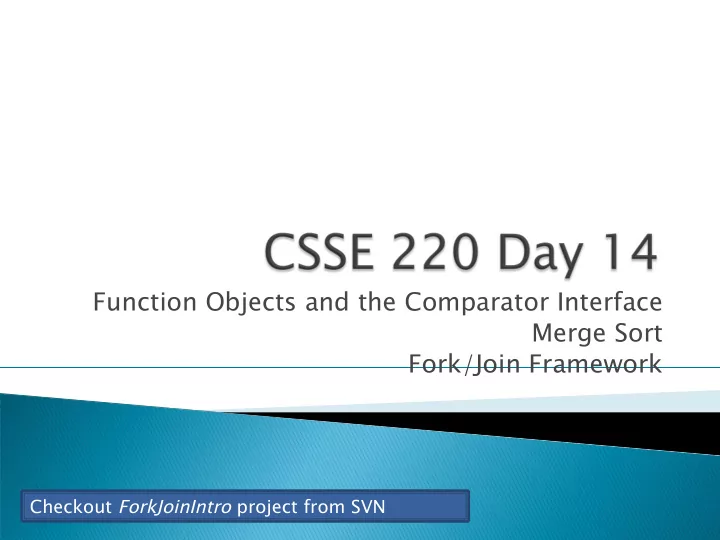

Function Objects and the Comparator Interface Merge Sort Fork/Join Framework Checkout ForkJoinIntro project from SVN
} Merge sort recap } Introduction to function objects, Comparato tor } Parallelism with the Fork/Join Framework
} Basic recursive idea: ◦ If list is length 0 or 1, then it’s already sorted ◦ Otherwise: Divide list into two halves Recursively sort the two halves Merg Merge the sorted halves back together
If list is length 0 or 1, then it’s already sorted } Otherwise: ◦ Divide list into two halves ◦ Recursively sort the two halves ◦ Merg Merge the sorted halves back together Merge n items n items merged n items merged Merge n/2 items Merge n/2 items Merge n/4 Merge n/4 n items Merge n/4 Merge n/4 items items merged items items etc etc Merge 2 Merge 2 Merge 2 Merge 2 n items etc items items items items merged
Another way of creating reusable code
} Java libraries provide efficient sorting algorithms ◦ Arrays.sort(…) and Collections.sort(…) } But suppose we want to sort by something other than the “natural order” given by compareTo() } Function objects to the rescue!
} Objects defined to just “wrap up” functions so we can pass them to other (library) code } For sorting we can create a function object that implements Comparator } Let’s try it!
Function objects and recursion meet multicore computers Some slides and examples derived from Dan Grossman’s materials at http://www.cs.washington.edu/homes/djg/teachingMaterials/
} Sequential programming : one thing happens at a time ◦ No longer the case! } Parallel programming : multiple things happen simultaneously } Major challenges and opportunities ◦ Programming ◦ Algorithms ◦ Data We’ll just scratch the surface in CSSE 220
} Parallel code is often much harder to write than sequential } Free ride from the CPEs ◦ From 1980-2005 performance of same sequential code doubled every two years } No one knows how to continue this! ◦ Speed up clock rate? Two much heat Memory can’t keep up ◦ But the “wires” keep getting smaller, so… Put multiple processors on same chip!
} Run multiple totally different programs ◦ Operating system handles this ◦ Uses time-slicing plus multiple cores } Multiple things at once in one program ◦ We’ll play with this today!
} Parallelism : Use more resources for a faster answer } Concurrency : Correctly and efficiently allow simultaneous access to data
} CS1 idea: Writing a program is like writing a recipe for a cook } Parallelism: slicing lots of potatoes } Concurrency: sharing stove burners
+ + + + + + + + + + + + + + + } Example: Sum elements of a large array } Use divide-and-conquer! ◦ Parallelism for the recursive calls
} Specifically for recursive, divide-and- conquer parallelism ◦ Is in Java 7 standard libraries, but available in Java 6 as a downloaded .jar file } Fork : splitting off some code that can run in parallel with the original code ◦ Like handing a potato to a helper } Join : waiting for some forked code to finish ◦ Like waiting for the potato slices from the helper
} Set a sequential threshold ◦ A size below which we just “slice ‘em ourselves” } Library needs to “warm up” ◦ Java Virtual Machine optimizes as it runs } Wait until your computer has more processors J } Here there be dragons! ◦ Memory-hierarchy issues ◦ Race conditions ◦ We’re ignoring lots of gory details!
} Find a partner for HW14 } You’ll: ◦ Write some code ◦ Run some experiments ◦ Write a lab report } This is the third year we’ve tried this: ◦ Enjoy playing with the tools and ideas ◦ Ask questions! Follow the written homework instructions carefully. There’s a lot more independent learning here than we’ve been doing so far.
Recommend
More recommend